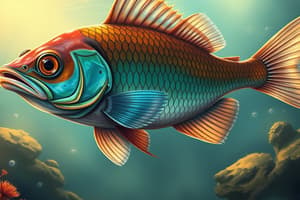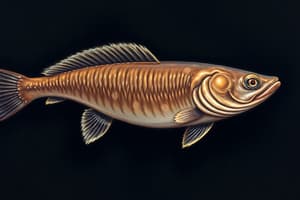Podcast
Questions and Answers
What is the primary function of the dorsal nerve cord in Agnatha?
What is the primary function of the dorsal nerve cord in Agnatha?
- Locomotion
- Nervous system control (correct)
- Respiration
- Digestion
Which feature distinguishes the class Chondrichthyes from Agnatha?
Which feature distinguishes the class Chondrichthyes from Agnatha?
- Absence of a stomach
- External fertilization
- Numerous gills
- Presence of jaws (correct)
In which class are the gill slits used for respiration mainly found?
In which class are the gill slits used for respiration mainly found?
- Cephalospidomorphi (correct)
- Mammalia
- Aves
- Amphibia
What is a notable reproductive characteristic of Agnatha?
What is a notable reproductive characteristic of Agnatha?
How do Agnatha primarily obtain blood from their prey?
How do Agnatha primarily obtain blood from their prey?
Which evolutionary adaptation aids Agnatha in moving through water?
Which evolutionary adaptation aids Agnatha in moving through water?
What type of skeletal system do Chondrichthyes possess?
What type of skeletal system do Chondrichthyes possess?
Which subclass of mammals is primarily characterized by egg-laying?
Which subclass of mammals is primarily characterized by egg-laying?
Which of the following is a common characteristic of Myxini?
Which of the following is a common characteristic of Myxini?
What is one key feature that differentiates marsupials from other mammals?
What is one key feature that differentiates marsupials from other mammals?
What is a common characteristic shared by all mammals?
What is a common characteristic shared by all mammals?
Which of the following statements is true regarding the prototheria subclass?
Which of the following statements is true regarding the prototheria subclass?
Which mammal is an example of a monotreme?
Which mammal is an example of a monotreme?
In which type of environment do members of the Metatheria subclass primarily live?
In which type of environment do members of the Metatheria subclass primarily live?
What is a defining characteristic of the young of marsupials at birth?
What is a defining characteristic of the young of marsupials at birth?
What unique feature do monotremes possess that distinguishes them from other mammals?
What unique feature do monotremes possess that distinguishes them from other mammals?
What is the primary method of reproduction in sponges?
What is the primary method of reproduction in sponges?
Which of the following is not a subphylum of Chordata?
Which of the following is not a subphylum of Chordata?
What are spicules made of in sponges?
What are spicules made of in sponges?
Which of these options does not pertain to a deuterostome?
Which of these options does not pertain to a deuterostome?
What type of cells in sponges are responsible for feeding?
What type of cells in sponges are responsible for feeding?
Which organism has a gastrovascular cavity?
Which organism has a gastrovascular cavity?
Which statement is true regarding the nervous system of sponges?
Which statement is true regarding the nervous system of sponges?
How do sponges primarily facilitate gas exchange?
How do sponges primarily facilitate gas exchange?
Amphibians arose from which group of fish?
Amphibians arose from which group of fish?
What does the term 'amphibian' refer to?
What does the term 'amphibian' refer to?
What is notable about the regeneration ability of sponges?
What is notable about the regeneration ability of sponges?
In what form is digestion accomplished within sponges?
In what form is digestion accomplished within sponges?
Which of the following classes of vertebrates has a four-chambered heart?
Which of the following classes of vertebrates has a four-chambered heart?
Which of the following correctly describes the evolutionary significance of sponges?
Which of the following correctly describes the evolutionary significance of sponges?
Which of the following does not describe a characteristic of platyhelminthes adapted for parasitism?
Which of the following does not describe a characteristic of platyhelminthes adapted for parasitism?
Which of the following accurately describes ectothermic animals?
Which of the following accurately describes ectothermic animals?
What is a defining characteristic of amphibians regarding their limbs?
What is a defining characteristic of amphibians regarding their limbs?
Which of the following respiratory methods is used by adult amphibians?
Which of the following respiratory methods is used by adult amphibians?
What type of circulatory system do amphibians possess?
What type of circulatory system do amphibians possess?
Which reproductive method is most commonly observed in amphibians?
Which reproductive method is most commonly observed in amphibians?
What is the body temperature regulation method of amphibians?
What is the body temperature regulation method of amphibians?
Which of the following adaptations help amphibians transition from water to land?
Which of the following adaptations help amphibians transition from water to land?
What type of circulatory system allows respiration through both lungs and skin in amphibians?
What type of circulatory system allows respiration through both lungs and skin in amphibians?
What distinguishes amphibians from other vertebrates in terms of their reproductive development?
What distinguishes amphibians from other vertebrates in terms of their reproductive development?
Flashcards are hidden until you start studying
Study Notes
Superclass Agnatha
- Comprised of jawless fish, including Hagfish (Myxine) and Lamprey (Petromyzon marinus).
- Five to sixteen gills are used for respiration in Myxini; Cephalospidomorphi have seven pairs with external openings.
- Lacks a stomach; features a dorsal nerve cord and differentiated brain.
- External fertilization occurs with no larval stage; sexes are separate.
- Adaptations include long, slender, limbless body and slimy skin for reduced water resistance.
- Tail with caudal fin enhances forward thrust; buccal funnel and toothed tongue adapted for blood-sucking.
Superclass Gnathostomata
- Comprised of six classes: Chondrichthyes, Osteichthyes, Amphibia, Reptilia, Aves, and Mammalia.
Class Chondrichthyes
- Known as cartilaginous fishes, including sharks, rays, and skates.
- Possess jaws evolved from the first pair of gill arches; skeletons are largely cartilaginous.
- Body shape is laterally compressed and fusiform; mouth is located ventrally.
Class Amphibia
- Body forms vary, with a clear division into head and trunk.
- Most have two pairs of pentadactyl limbs; some, like caecilians, lack legs.
- Skin is smooth, moist, and highly vascular, often with glandular structures.
- Respiration in larval stage is via gills, whereas adults use lungs and skin.
- Heart has three chambers; undergoes double circulation.
- Fertilization can be external or internal; most are oviparous with a metamorphic life cycle.
- Temperature regulation is poikilothermic, leading to behaviors such as hibernation.
Evolutionary Adaptations in Amphibia
- Significant transition from aquatic to terrestrial life.
- Adaptations include limbs for movement, lungs for air breathing, and internal nares for closed-mouth breathing.
- Slimy skin helps prevent desiccation.
- Circulatory system adapted for lung and skin respiration; reduced skeletal mass for a lighter body.
Classification of Mammals
- Divided into three subclasses: Prototheria (egg-laying), Metatheria (pouched), and Eutheria (placental).
- Prototheria exemplifies a link between reptiles and mammals; features include cloaca and mammary glands.
- The Duckbill platypus and Echidna are key examples of monotremes.
Subclass Metatheria - Marsupials
- Females possess a pouch (marsupium) for immature young.
- Young are nurtured in the pouch until maturing; significant examples include Opossum, Kangaroo, and Tasmanian wolf.
Sponges
- Totally lack a nervous system; composed of various spicule shapes forming a skeletal framework.
- Involuntary digestion occurs intracellularly within choanocytes, with respiration facilitated through diffusion and water currents.
- Reproduction is both sexual (egg and sperm) and asexual (budding or gemmules).
- Known for exceptional regenerative capabilities; evolved from protists called choanoflagellates.
- Economic uses include personal hygiene, medical procedures, and architectural soundproofing.
General Features of Animals and Classification Criteria
- Distinct features: multicellular, heterotrophic metabolism, specialized tissues, mobility.
- Criteria for classification generally encompass anatomical, physiological, and genetic characteristics.
- Radial symmetry adapts organisms to a sessile or free-floating lifestyle; bilateral symmetry allows for directional movement.
Responses to Questions
- Amphibians arose from jawless fish.
- Deuterostome characteristics include blastopore associated with the anus, enterocoelom, and inclusion of echinoderms and chordates.
- Gastrovascular cavities are found in flatworms.
- Non-chordate subphylum: Hemichordata.
- Ectothermic animals (like fish) regulate body temperature externally; endothermic (like mammals) regulate internally.
Studying That Suits You
Use AI to generate personalized quizzes and flashcards to suit your learning preferences.




